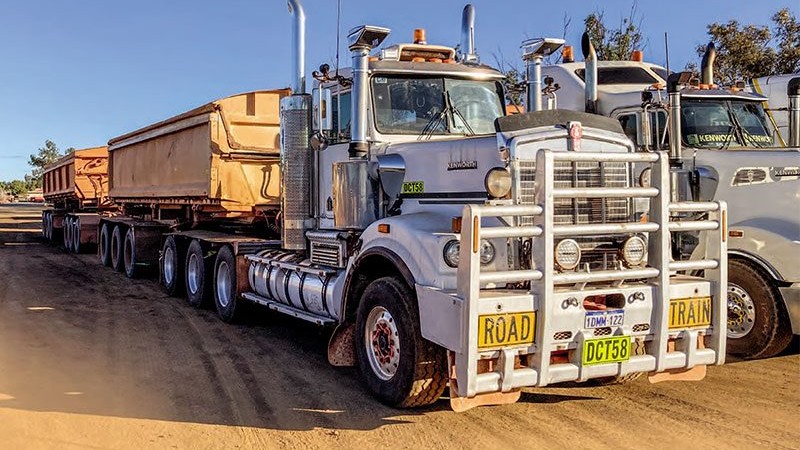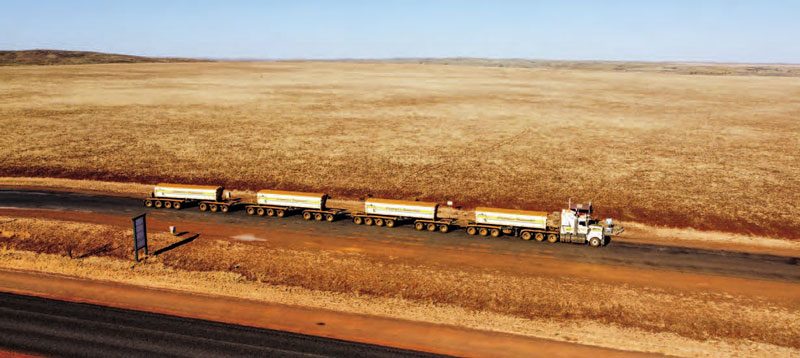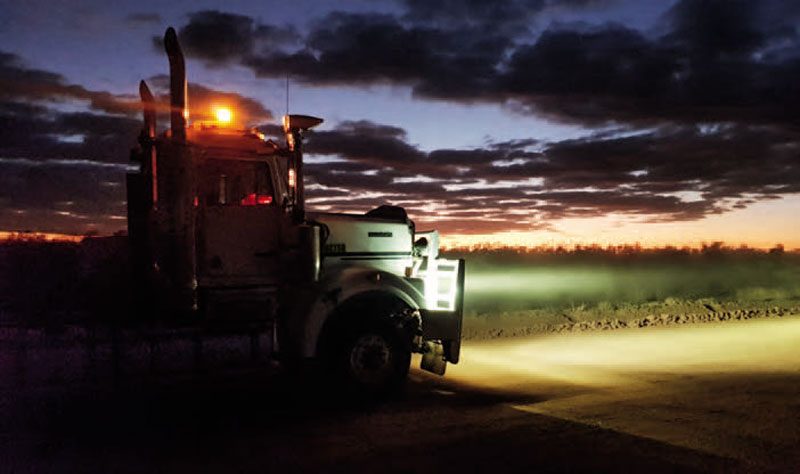
Mike Williams reveals what it’s really like to drive in this mineral-rich but sparsely populated part of north Western Australia.
I ended up working in the Pilbara by accident. I’d planned to go to Perth with my other half to spend some time with grandchildren we hadn’t met thanks to the whole Covid-19 mess. I’d lined up a job driving a tanker based in Perth, and I started there, but pretty soon I realised I wasn’t a good fit for the place and I decided to look at other options.
The biggest thing I’d driven until then was a standard triple road train, carting general freight. I could write what I knew about tippers on the back of a matchbox. I’d never even seen a side tipper up close, let alone tipped one or even seen one tipped. I was thinking the chances of me getting a go in the Pilbara were pretty low.
I spent a few days ringing around and talking with friends, and I finally got on to Campbell Transport. Then it was a whirlwind experience! In for a medical, and a couple of days doing inductions and then on a plane to Port Hedland. Since my other half was staying in Perth, I went on a two-and-one contract; two weeks on, one week off. Eastern-staters usually go on 4:2 rosters.

I had a number to ring when I got off the plane, and I was collected from the airport. I was taken to the Campbell yard in Port Hedland. There’s plenty of big iron laying about there. They had care packages made up for the three of us new-starters with all the information we needed. We’d each been allocated rooms in a share house, and we had some maps and even some breakfast cereal. We were given a little car to drive around, pointed in the right direction. “Be back here in the morning at 0800. Don’t get into any trouble!”
So here we are. I got lost finding the share house. No big surprise there. I got lost finding the supermarket, again not a surprise. The adventure had begun.
Campbells knew I had no side tipper experience when I was offered a start. It had trucks on a job that’s a great training ground. I started in a standard configuration type 1 road train (two trailers and a dolly), a day cab C509 Kenworth with a couple of side tippers and a trainer sitting beside me. It was a really good start. I wasn’t daunted by the truck; I could drive a road train. I was there to learn how to load and tip the trailers. I’m not going to say it was easy, but thankfully I picked it up pretty quickly. After a couple of days, I was flying solo. By the time I’d finished my first swing, I felt pretty confident about stepping up.
It wasn’t long before I got sent on a run in a quad with another driver. It was supposed to be a ride in the passenger seat to see the job. I went with Jarrod, a Kiwi bloke from Auckland. We got talking about what I’d been doing, and not long after that, he wheeled her into a parking bay and I was getting a steer. I’ll never forget the first time I looked in the mirror. A tri-drive T909 Kenworth Ultra Quad, big X-15 Cummins, 18-speed Roadranger, 60m long, 58-tonnes tare weight. It’s a lot of truck and, if I’m honest, I was a bit nervous. It was time to walk the walk.
I managed to put in a satisfactory performance and spent the next few days working with different drivers while they sat in the passenger seat and guided me through the job. There’s plenty to learn – all the radio calls and how to interact with the mine site and machine operators. It’s a pretty steep learning curve if you’ve never been involved in mining before. Then I had to take the test! You have to get signed off that you are competent at every aspect of the job. That means the test lasts for the whole shift. Now I suppose this may sound stressful, but it’s really not. Someone had been watching over my shoulder the entire time, and I’d already had a bit to do with the bloke whose signature I needed, so it was really just another day in the saddle.
At the end of the shift, I was signed off and good to go. It’s a milestone in my driving career I’m proud of, and it wouldn’t have happened without the willingness of Campbells to train drivers and the quality of the operators I was lucky enough to work with and learn from. Now I could operate the largest trucks running regularly on public roads anywhere in Australia and, as far as I know, anywhere in the world. Yes, there are trucks carrying bigger payloads, but here we’re talking regularly on a job on public road. That’s the difference.

So what’s the reality when you’re doing it? I hear you ask.
As I said, you’re in a share house. Campbells likes to have three drivers sharing a house, a car and a truck. There are two drivers in the house and one on R&R. For me, fly-in day was Tuesday – that’s the day the truck goes through the workshop and is thoroughly serviced and inspected. The two guys I teamed up with had a system we’d worked out. Obviously, as I flew in, one was flying out. I picked up the car from the airport and went and did my shopping for the first week. Then I drove to the house and got sorted out. My cross-shift driver would be on a 24-hour break. I would take the truck for the next run as soon as it was ready from the workshop. The cross- shift would drop me at the workshop when the truck was on the go line.
Then it’s on. I have to say the rolling shifts were the hardest thing for me to deal with. It’s relentless. The mine we were going to meant the trip, depot to depot, including unloading, took about 11 hours. Once again, we had a system. Ring up from the Newman T – that’s the intersection where the coast road to Karratha and the Great Northern Highway come together – gives you about an hour to get up, get sorted out, have a shower and a bite to eat and get your game face on. Then we’d get sent a text when we had a bunker allocated to tip-off at the port. That’s like a half-hour warning. Then another text when we were leaving the port. Time to get in the car and head to the yard. Meet up at the fuel pumps after signing in and blowing in the breatho. Fill a couple of the big square tanks and do the pre-trip, and off you go. Run empty down to the mine, load, and back to the port. Then back to the depot and back to the house, shower, eat, sleep, rinse, repeat!
It’s good money. There’s lots to do in the community if you can find the time and the motivation. With a 24-hour break in the swing, there’s a chance to go for an explore or go fishing if you’re into that. Then there’s the week off at home for the WA locals.
I’ve had worse jobs.
Read more
The sale is on!
0 Comments7 Minutes
Running north
0 Comments13 Minutes
Changing the Game
0 Comments10 Minutes







